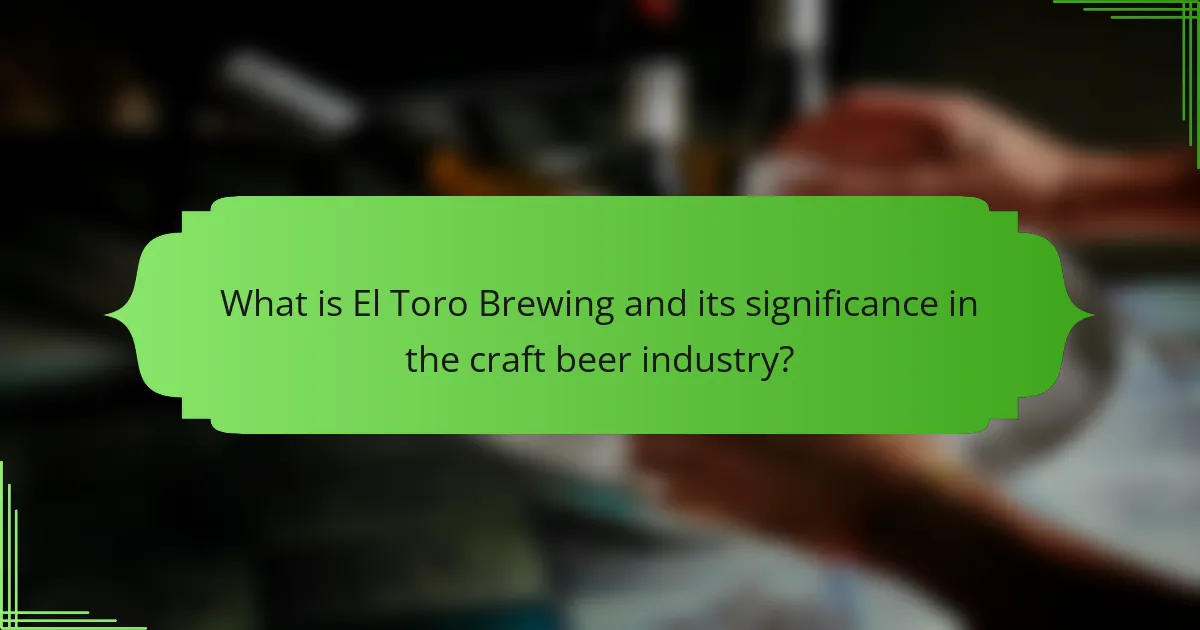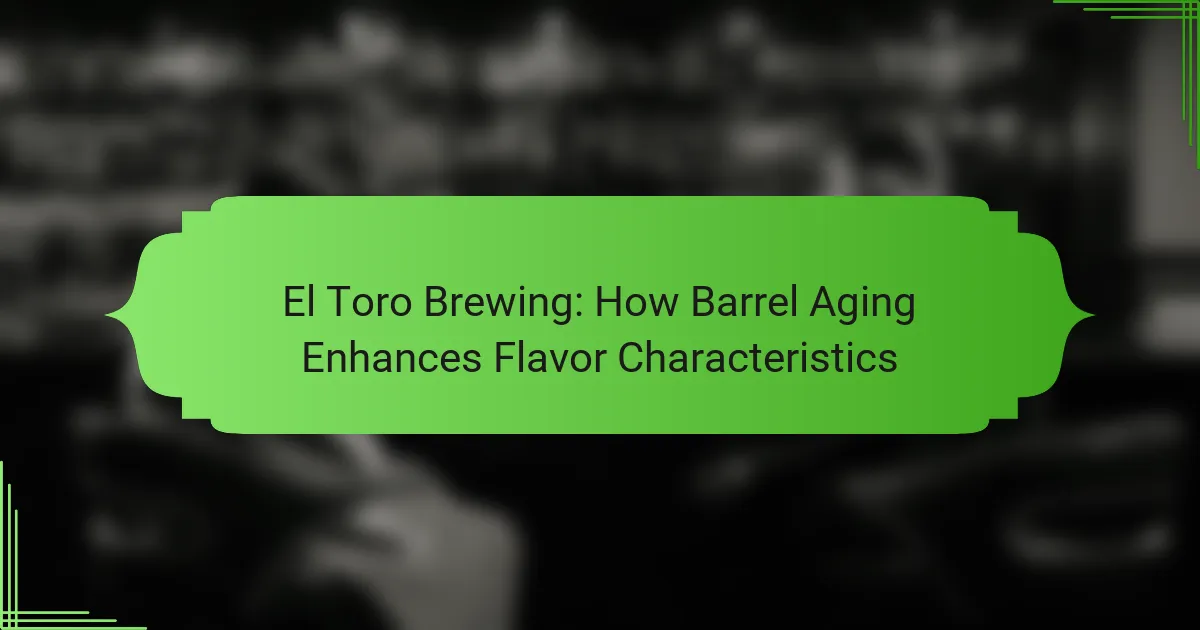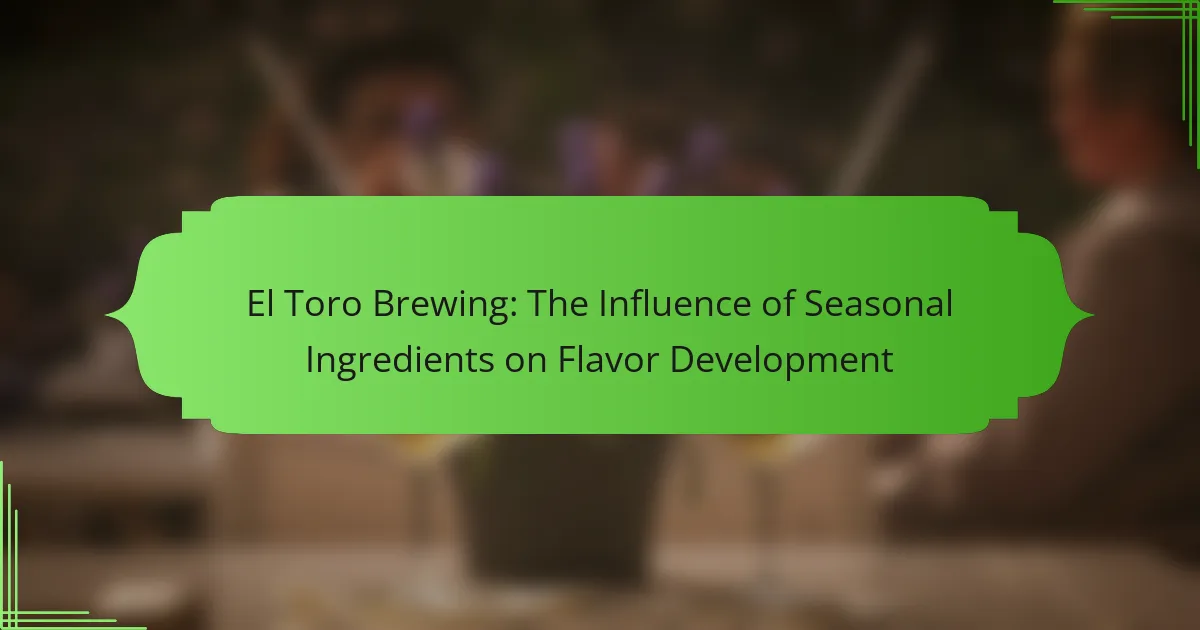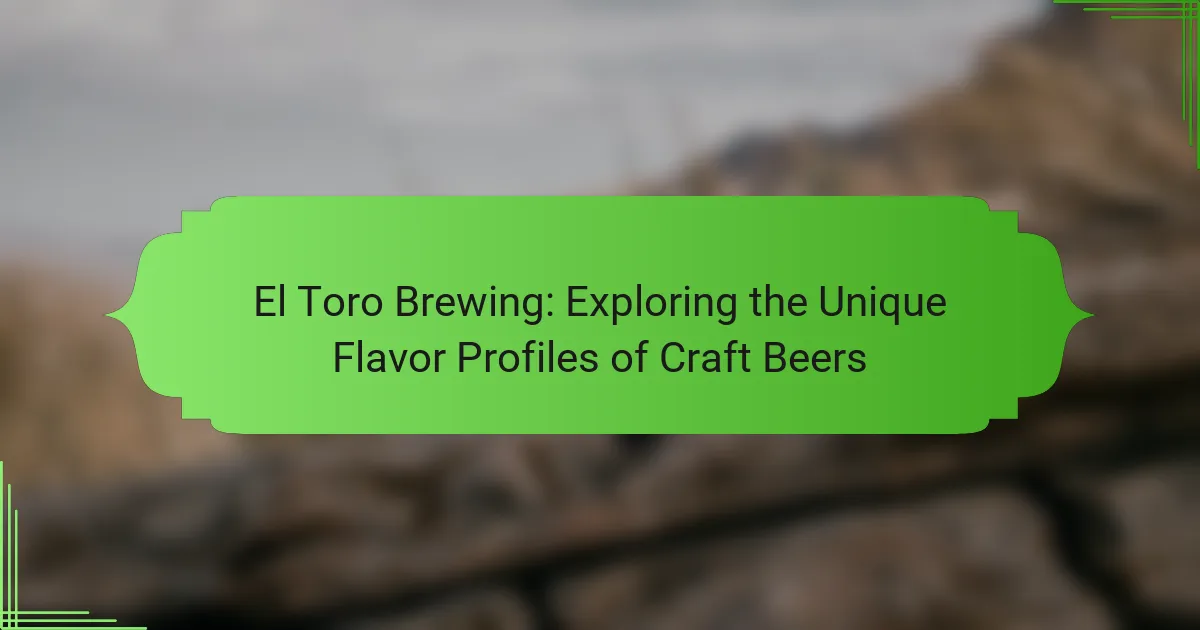El Toro Brewing is a craft brewery established in 2014, recognized for its innovative barrel-aging techniques that enhance the flavor complexity of its beers. The brewery prioritizes high-quality ingredients and unique brewing methods, setting it apart within the craft beer community. El Toro Brewing’s barrel-aging process infuses diverse flavors from various wood types, contributing to its award-winning offerings. This commitment to craftsmanship not only highlights the brewery’s significance in the market but also supports the overall growth of the craft beer industry. The article will explore how barrel aging enhances flavor characteristics and the impact of these practices on El Toro Brewing’s reputation.

What is El Toro Brewing and its significance in the craft beer industry?
El Toro Brewing is a craft brewery known for its innovative approach to brewing. It specializes in barrel-aged beers that enhance flavor complexity. Established in 2014, El Toro Brewing has gained recognition within the craft beer community. The brewery emphasizes high-quality ingredients and unique brewing techniques. Its barrel-aging process allows for the infusion of diverse flavors from various wood types. This method sets El Toro apart from many other breweries. The brewery’s commitment to craftsmanship contributes to the overall growth of the craft beer industry. Its offerings have won multiple awards, showcasing its significance in the market.
How does El Toro Brewing differentiate itself from other breweries?
El Toro Brewing differentiates itself through its unique barrel aging techniques. The brewery specializes in aging beers in various types of barrels, including whiskey and wine barrels. This process enhances the flavor profile of their beers significantly. El Toro Brewing uses locally sourced ingredients to create distinctive flavors. Their commitment to small-batch production allows for greater experimentation. They also focus on limited releases, which creates exclusivity for their products. The brewery’s innovative approach attracts craft beer enthusiasts seeking unique experiences. Overall, their emphasis on barrel aging and local sourcing sets them apart in the competitive brewery landscape.
What unique brewing techniques does El Toro Brewing employ?
El Toro Brewing employs a unique barrel aging technique to enhance flavor characteristics. This method involves aging their beers in previously used barrels, which impart distinct flavors. The barrels can be sourced from various spirits, such as bourbon or rum. Each type of barrel contributes unique notes to the beer. El Toro Brewing carefully selects these barrels to complement specific beer styles. The aging process allows for deeper flavor integration over time. This technique results in complex, layered tasting profiles. The brewery’s commitment to this method showcases their innovative approach to brewing.
What is the history behind El Toro Brewing?
El Toro Brewing was founded in 2015 in North Carolina. The brewery was established by a group of craft beer enthusiasts. They aimed to create unique and flavorful beers. The founders focused on using high-quality ingredients. They also emphasized the importance of barrel aging. This technique enhances the flavor characteristics of their brews. El Toro Brewing quickly gained recognition in the craft beer community. Their innovative approach has led to numerous awards and accolades.
What role does barrel aging play in enhancing flavor characteristics?
Barrel aging plays a significant role in enhancing flavor characteristics by allowing the beverage to interact with the wood. This interaction extracts compounds from the barrel, such as tannins and vanillin, which contribute to the flavor profile. The aging process also promotes oxidation, which can soften harsh flavors and add complexity. Additionally, the wood can impart unique notes, such as caramel, spice, or smoke, depending on the type of barrel used. Studies have shown that different barrels, such as bourbon or wine barrels, influence the final product’s taste. For example, bourbon barrels often add sweet and oaky flavors, while wine barrels can introduce fruity and floral notes. Thus, barrel aging is essential for developing rich and diverse flavor characteristics in beverages.
How does barrel aging affect the taste profile of beers?
Barrel aging significantly influences the taste profile of beers. It introduces complex flavors from the wood, such as vanilla, caramel, and oak. The interaction between the beer and the barrel enhances depth and richness. Additionally, barrel aging can impart subtle notes of spices and fruit. The aging process allows for oxidation, which can soften harsh flavors and create smoother profiles. It also promotes the development of unique characteristics based on the type of wood used. Studies indicate that beers aged in bourbon barrels often exhibit higher sweetness levels due to residual sugars. Overall, barrel aging transforms the flavor experience, making it more nuanced and appealing.
What types of barrels are used in the barrel aging process?
The types of barrels used in the barrel aging process include oak barrels, stainless steel barrels, and ceramic vessels. Oak barrels are the most common choice due to their ability to impart flavors and tannins. They can be further categorized into American oak and French oak, each providing distinct flavor profiles. Stainless steel barrels are often used for aging spirits and some wines, as they do not add any flavors but allow for controlled oxidation. Ceramic vessels, although less common, are used for specific types of beverages, offering a neutral aging environment. The choice of barrel affects the final flavor and aroma of the aged product.
What are the benefits of barrel aging for El Toro Brewing’s products?
Barrel aging enhances the flavor characteristics of El Toro Brewing’s products by imparting complex flavors and aromas. The process allows the beer to absorb compounds from the wood, such as vanillin and tannins. These compounds contribute to notes of vanilla, oak, and spice. Additionally, barrel aging can lead to a smoother mouthfeel and a more rounded flavor profile. The interaction with the wood can also promote oxidation, which can enhance the depth of flavor. This aging process typically results in a richer, more nuanced beer. Many craft breweries, including El Toro Brewing, utilize this method to differentiate their offerings in a competitive market.
How does barrel aging influence the aroma and mouthfeel of the beer?
Barrel aging significantly enhances the aroma and mouthfeel of beer. The process allows the beer to absorb compounds from the wood, such as vanillin and lactones. These compounds contribute to complex aromas, including vanilla, coconut, and spices. As the beer ages, oxidation occurs, leading to a smoother mouthfeel. This smoothness is often described as creamy or velvety. Additionally, barrel aging can introduce tannins, which add structure and a slight astringency. Studies show that beers aged in barrels exhibit richer flavor profiles compared to non-aged counterparts. Overall, barrel aging transforms the sensory experience of beer, creating depth and complexity.
What flavors are typically introduced through barrel aging?
Barrel aging typically introduces flavors such as vanilla, caramel, oak, and spice. These flavors result from the interaction between the beverage and the wood of the barrel. The toasting and charring of the barrel create compounds that impart these flavors. For example, vanillin contributes to the vanilla notes. Tannins from the wood add complexity and structure. Additionally, the aging process allows for oxidation, which can enhance fruity or nutty characteristics. Studies show that different types of wood can influence flavor profiles significantly. For instance, American oak often imparts stronger vanilla and coconut notes compared to European oak.
How does El Toro Brewing select barrels for aging its beers?
El Toro Brewing selects barrels for aging its beers based on specific criteria. They prioritize the type of wood used in the barrels. Commonly, they utilize American oak and French oak. Each type contributes distinct flavor profiles to the beer. The brewery also considers the previous contents of the barrels. Barrels previously used for bourbon or wine add unique characteristics. Additionally, they evaluate the barrel’s age and condition. Newer barrels impart stronger flavors, while older barrels offer subtler notes. This selection process ensures a well-rounded flavor in their aged beers.
What factors are considered when choosing barrels for aging?
Factors considered when choosing barrels for aging include wood type, previous contents, barrel size, and toasting level. The wood type affects the flavor profile. Common choices are oak and cherry. Previous contents, such as bourbon or wine, impart distinct characteristics. Barrel size influences the surface area to volume ratio. Smaller barrels enhance flavor extraction. The toasting level affects the release of compounds. Light toasting provides subtle flavors, while heavy toasting adds richness. These factors collectively shape the final flavor of the aged product.
How does the previous use of a barrel impact the aging process?
The previous use of a barrel significantly impacts the aging process by imparting flavors and characteristics from prior contents. Barrels previously used for spirits or wine can introduce notes such as vanilla, caramel, or oak to the aging beverage. These flavors are absorbed into the wood and released during the aging process. The interaction between the beverage and the barrel also allows for oxidation, which can enhance complexity. Additionally, the residual sugars and compounds from previous contents can affect the final taste profile. Studies show that barrel aging can improve the overall quality of the beverage, making it smoother and more aromatic. For instance, whiskey aged in barrels previously used for sherry can exhibit unique flavor dimensions that are not present in new barrels.
What are the challenges associated with barrel aging at El Toro Brewing?
Barrel aging at El Toro Brewing presents several challenges. Controlling the temperature and humidity during the aging process is crucial. Fluctuations can impact the flavor profile of the beer. Additionally, the selection of barrels is critical. Different wood types can impart unique flavors, affecting the final product. Managing oxidation levels is another challenge. Excessive oxidation can spoil the beer. The duration of aging also poses difficulties. Aging too long can lead to overpowering flavors. Finally, consistency in production is essential. Variability in barrel characteristics can lead to inconsistent batches.
How does the aging process affect production timelines?
The aging process extends production timelines significantly. This is due to the time required for flavors to develop in barrel-aged products. Typically, barrel aging can take several months to years. During this period, the beverage interacts with the wood, extracting compounds that enhance flavor. For example, bourbon barrels impart vanilla and caramel notes. The longer the aging, the more complex the flavor profile becomes. However, this requires careful monitoring to prevent over-aging. The extended timeline is essential for achieving desired taste characteristics.
What quality control measures are implemented during barrel aging?
Quality control measures during barrel aging include regular sensory evaluations and chemical analysis. Sensory evaluations involve tasting and smelling the product at various stages. This helps identify flavor development and potential defects. Chemical analysis monitors compounds like acidity and alcohol levels. It ensures consistency and quality throughout the aging process. Additionally, visual inspections check for leaks and wood integrity. These measures help maintain the desired flavor profile and overall quality of the final product.
What are some popular barrel-aged beers from El Toro Brewing?
El Toro Brewing is known for its distinctive barrel-aged beers. Some popular options include their Barrel-Aged Imperial Stout. This stout is rich and complex, featuring notes of chocolate and coffee. Another favorite is the Barrel-Aged Brown Ale. It offers a smooth, malty flavor with hints of caramel and vanilla. Additionally, their Barrel-Aged IPA has garnered attention for its unique hoppy profile combined with oak characteristics. These beers showcase the brewery’s expertise in barrel aging, enhancing their flavor profiles significantly.
How do these beers exemplify the benefits of barrel aging?
Barrel-aged beers exemplify the benefits of barrel aging by developing complex flavors and aromas. The interaction with the wood adds notes of vanilla, caramel, and spice. These flavors enhance the overall taste profile of the beer. Aging in barrels also allows for oxidation, which can soften harsh flavors. This process results in a smoother mouthfeel. Additionally, the beer can absorb residual flavors from previous contents of the barrel. For instance, whiskey barrels impart unique characteristics that differentiate the beer. Studies show that barrel aging can increase the beer’s aromatic complexity significantly. This multifaceted enhancement makes barrel-aged beers highly sought after.
What feedback do consumers provide about these barrel-aged offerings?
Consumers generally praise barrel-aged offerings for their complex flavors and aromas. Many note the rich, deep notes of vanilla, oak, and caramel. Feedback often highlights the smoothness and balance achieved through aging. Some consumers appreciate the unique characteristics that different barrels impart. Others comment on the enhanced mouthfeel and overall drinking experience. Reviews frequently mention the improved depth compared to non-barrel-aged options. Consumers also express enjoyment of the subtleties introduced by the aging process. This feedback reflects a strong preference for the craftsmanship involved in barrel aging.
What tips can homebrewers learn from El Toro Brewing’s barrel aging techniques?
Homebrewers can learn several key tips from El Toro Brewing’s barrel aging techniques. First, selecting the right type of barrel is crucial. Different woods impart unique flavors. Second, the aging duration significantly affects the beer’s profile. El Toro often experiments with various aging times to achieve desired results. Third, monitoring temperature and humidity during aging is essential. These factors can influence the extraction of flavors from the wood. Fourth, blending aged beer with younger batches can create complex flavor profiles. This technique is commonly used by El Toro to enhance their offerings. Lastly, regular tasting during the aging process allows brewers to assess flavor development. This practice ensures that the final product meets quality standards.
El Toro Brewing is a craft brewery established in 2014, recognized for its innovative barrel-aging techniques that enhance the flavor complexity of its beers. The article explores how El Toro Brewing differentiates itself through its unique barrel aging process, the types of barrels used, and the impact of this method on the taste profile, aroma, and mouthfeel of their products. It also discusses the challenges associated with barrel aging, quality control measures, and highlights popular barrel-aged offerings. Additionally, insights for homebrewers on adopting similar techniques are provided, emphasizing the importance of barrel selection and monitoring during the aging process.


